How to Design a Seasonal Japanese Garden
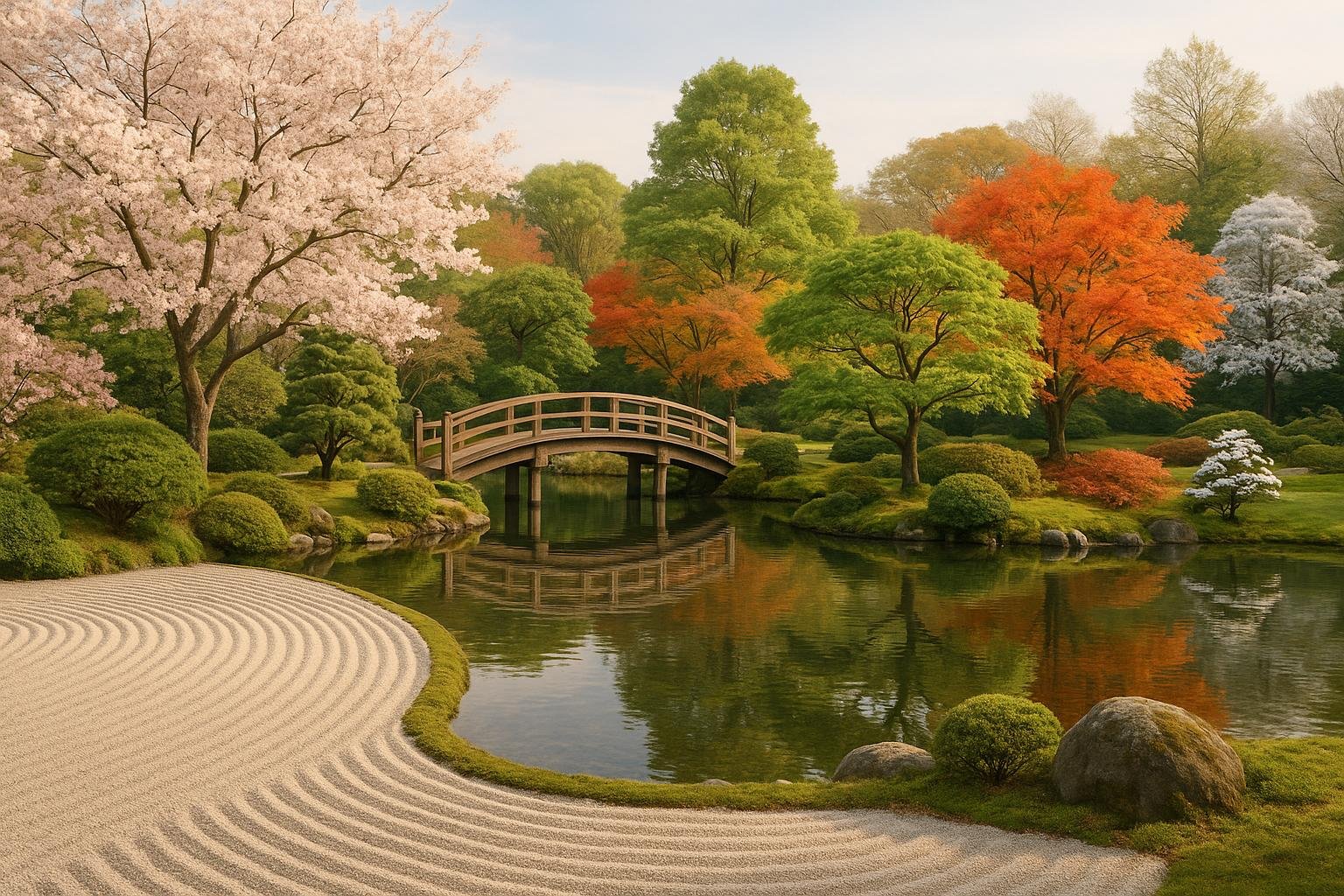
Designing a seasonal Japanese garden involves creating a space that transforms with nature’s rhythm, emphasizing balance and harmony. These gardens focus on the interplay of stone, water, and plants, highlighting the beauty of spring blossoms, summer greenery, autumn foliage, and winter stillness. Unlike Western gardens, they celebrate nature’s cycles rather than constant vibrancy. Key principles include:
- Seasonal Focus: Use plants like cherry trees for spring, maples for autumn, and evergreens for winter.
- Core Elements: Incorporate stones, water features, and plants to represent natural landscapes.
- Design Styles: Choose from hill gardens, dry gardens, or tea gardens to suit your space.
- Seasonal Transitions: Plan layouts with winding paths and focal points to reveal seasonal highlights gradually.
Modern tools like AIGardenPlanner simplify the process by tailoring designs to your space, climate, and preferences, while also providing maintenance schedules and care tips. A well-designed Japanese garden offers a serene retreat that evolves beautifully throughout the year.
Year-Round Japanese Garden Design | Seasonal Plants for Every Zen Moment

Basic Principles of Japanese Garden Design
Japanese garden design has evolved over more than 1,300 years, creating serene spaces that reflect nature's beauty and inspire quiet reflection. By understanding the key principles behind these gardens, you can design a space that embodies the essence of Japanese aesthetics while embracing the ever-changing seasons.
Why Seasonal Changes Matter in Japanese Gardens
Seasonal transitions are at the core of Japanese garden philosophy. Unlike Western gardens that often aim for constant vibrancy, Japanese gardens celebrate the natural ebb and flow of each season. Spring’s blossoms, summer’s lush greenery, autumn’s fiery hues, and winter’s stark silhouettes are all given equal attention in the design process, reflecting a deep cultural connection to nature’s cycles [6]. Influenced by Buddhist, Shinto, and Taoist traditions [5], this philosophy shapes everything from plant selection to the placement of viewing points.
To design a garden that honors this principle, choose plants that highlight seasonal beauty. For example, cherry trees can showcase spring, while maples bring autumn to life. The goal is to create a space where every season tells its own story [1].
Main Design Elements: Simplicity, Balance, and Natural Materials
At its heart, Japanese garden design revolves around three core elements: stone, water, and plants. These are arranged with clean, simple lines to evoke a sense of natural harmony [5]. Unlike Western gardens, which often emphasize symmetry, Japanese gardens embrace asymmetry to mimic nature’s unpredictability. This approach creates what some describe as a "miniature and idealized view of nature" [4].
Andrea Beck captures this idea beautifully:
"Japanese garden design principles strive to inspire peaceful contemplation." [5]
The asymmetry not only reflects nature’s organic forms but also enhances the garden’s ability to highlight seasonal transitions. Balance in this context doesn’t mean perfect symmetry; instead, it’s about thoughtfully offsetting larger, heavier elements like rocks with lighter features such as delicate plants or open spaces. The guiding principle of “less is more” ensures that each element contributes to a harmonious whole [6].
Natural materials also play a symbolic role. Rocks can stand in for mountains, ponds can represent seas, and gravel in dry gardens often symbolizes water [4]. Carefully pruned trees reveal their architectural beauty, adding to the garden’s serene atmosphere. As Patricia Benner of Benner Reibel Landscape Architects explains:
"Japanese gardens are spatially disciplined and precise, offering meditative clarity." [7]
To create a welcoming and intimate space, scale all elements to human dimensions. This thoughtful approach fosters comfort and connection [6].
Types of Japanese Gardens and Seasonal Features
Traditional Japanese garden styles naturally highlight seasonal changes through their unique layouts and design elements. Three key styles - tsukiyama (hill gardens), karesansui (dry gardens), and chaniwa (tea gardens) - offer distinct ways to showcase the beauty of each season [1].
- Hill gardens (tsukiyama): These incorporate elevation changes, water features, and diverse plantings to create dynamic seasonal scenes. Cherry blossoms in spring and maple leaves in autumn shine in this style.
- Dry gardens (karesansui): Using rocks and gravel to represent natural landscapes, these gardens may appear static at first glance. However, the interplay of light and shadow throughout the seasons, along with carefully placed seasonal plants, brings them to life.
- Tea gardens (chaniwa): Designed around the path to a tea house, these gardens emphasize intimate, seasonal details like winter moss or spring-blooming shrubs. They are particularly well-suited for smaller, urban spaces.
Richard Hartlage, Founding Partner at Land Morphology, offers an insightful perspective:
"Japanese gardens are not intended to replicate nature but rather imply nature." [7]
This philosophy allows for creative adaptation to local climates and conditions. When designing for seasonal interest, focus on creating spaces that reveal themselves gradually. For example, paths that wind through the garden encourage visitors to discover seasonal highlights one step at a time [4]. Incorporating views of distant features, such as hills or mature trees beyond the garden’s borders, can further enhance the sense of space and connection to the landscape [4].
Molly Sedlacek, Founder and Principal at ORCA, sums it up perfectly:
"The beauty of a Japanese garden is that they are pared back to only what is necessary." [7]
This simplicity, paired with thoughtful design, creates a timeless space that evolves beautifully with the seasons.
Step-by-Step Guide to Planning Your Seasonal Japanese Garden
Creating a seasonal Japanese garden is all about designing a space where each season unveils its own charm while maintaining balance and harmony. By carefully arranging key elements, you can craft a garden that evolves beautifully throughout the year.
Planning Your Layout for Seasonal Highlights
The layout of a seasonal Japanese garden is thoughtfully organized to showcase the subtle changes that come with each season. Unlike gardens that rely on bold floral displays, Japanese gardens celebrate the understated beauty of nature's transitions[2]. Begin by identifying natural viewing points - these could be areas where visitors naturally pause or where sunlight creates dramatic effects. Place key seasonal features like a Japanese maple for its fiery autumn leaves or a cherry tree for its delicate spring blossoms. Keep in mind how sunlight shifts throughout the year to enhance these highlights.
Winding pathways are another essential feature. These paths should gently guide visitors, revealing seasonal changes gradually with each turn[9]. The goal is to create a sense of discovery, where every step offers a new perspective.
Once you’ve mapped out the layout, incorporate water and stone elements to add depth and further emphasize the seasonal narrative.
Adding Water Features and Stone Arrangements
Water and stone are the foundation of any Japanese garden, providing structure and a connection to nature. Garden expert Carole Jordorson explains their significance:
"Three of the essential elements used to create a Japanese garden are stone, which form the structure of the landscape; water, representing life-giving force; and plants, which provide the colour and changes throughout the seasons"[3].
Water features, such as ponds or bamboo fountains, bring tranquility and a dynamic element to the garden. A small pond can mirror cherry blossoms in spring, host lotus blooms in summer, and reflect the textured beauty of autumn leaves. The soothing sound of a bamboo fountain adds an auditory layer that complements the garden's visual and seasonal shifts.
Waterfalls, deeply rooted in Japanese traditions, carry symbolic meanings. In Shintoism, they are believed to attract gods, while in Buddhism, they represent paths to enlightenment[10]. Position waterfalls to blend seamlessly with the surrounding landscape, using moss-covered stones to frame the scene and create a timeless quality.
If space or practicality limits water features, dry gardens offer an elegant alternative. Raked gravel can mimic the flow of water, with ripple patterns evoking streams or waves[11].
Stone arrangements also require careful thought. Stones should appear stable and natural, with at least one-third of each stone buried for authenticity[10]. Arranging stones in scalene triangles, typically in odd numbers, ensures visual balance[10]. Stone lanterns, symbolizing the light of wisdom, serve as enduring focal points. Whether surrounded by fresh spring greens or warm autumn tones, these lanterns enhance the garden's seasonal atmosphere.
Designing a Flow Through the Seasons
To create a cohesive design, focus on seamless transitions between seasonal areas. A well-planned Japanese garden evolves naturally, offering beauty and interest year-round[12].
Repetition and connection are key to achieving this flow. Use consistent design elements, such as evergreen plants or recurring textures, to tie different sections together[13]. Evergreen foliage provides subtle transformations throughout the seasons, ensuring the garden remains vibrant even in winter[9].
Japanese maples are an excellent choice for their striking seasonal colors, while bamboo adds structure and movement with its rustling leaves and year-round appeal[2]. Vertical elements like pruned pines or bamboo screens help bridge seasonal zones, maintaining the garden's minimalist and balanced aesthetic.
For a more immersive experience, divide the garden into distinct seasonal zones. For example:
- A spring section with early-blooming shrubs near the entrance
- A summer area featuring water elements and shade-loving plants
- An autumn zone showcasing deciduous trees with vibrant foliage
- A winter garden accented by evergreens and snow-tolerant features
Winding paths and focal points, such as stone lanterns or unique trees, guide visitors naturally from one area to the next[13]. Thoughtful edge treatments also play a crucial role in tying the design together. As garden designer Marc Peter Keane notes:
"Everything of the whole is expressed at the edge. Along a path, something as simple as the treatment of the edges makes a difference in the whole design… creating an overall pattern and rhythmic flow"[10].
🚀 Ready to Reinvent Your Garden?
Join thousands of homeowners who have transformed their gardens using our AI design tool. Upload one photo to explore endless possibilities.
Get your AI garden designs →Choosing Plants for Each Season in the United States
Creating a seasonal Japanese garden in the U.S. means blending traditional aesthetics with local climate conditions. The plants you choose should not only complement the garden's layout but also highlight the transitions between seasons. Thoughtful selection can bring seasonal stories to life and guide visitors through an ever-changing landscape.
Spring Plants: Cherry Blossoms, Wisteria, and Camellias
Spring is a magical time in Japanese gardens, with cherry blossoms taking center stage as symbols of renewal and the fleeting beauty of life. Cherry trees, such as Yoshino and Kwanzan varieties, thrive in USDA zones 5–8 and are excellent choices for this season. If these aren't suitable for your area, Eastern redbud (Cercis canadensis) offers a native alternative with its delicate pink blooms.
Wisteria adds a touch of elegance with its cascading flowers. American wisteria (Wisteria frutescens) is a more manageable option compared to its Asian relatives, making it ideal for pergolas and arbors.
Camellias are another spring favorite, bridging late winter into early spring with their rose-like blooms. Camellia japonica thrives in zones 7–9, while Camellia sasanqua can handle slightly cooler conditions. These evergreen shrubs not only add beauty but also provide year-round structure to your garden.
For colder regions, flowering dogwood (Cornus florida) can replace Kousa dogwood, offering a similar aesthetic with its striking white bracts [8].
Summer Plants: Lotus, Hydrangeas, and Japanese Iris
Summer in a Japanese garden emphasizes lush greenery and the calming presence of water. Lotus (Nelumbo nucifera) is a standout choice, symbolizing purity and enlightenment. It thrives in full sun and warm water but can be grown as an annual or in movable containers in colder climates.
Hydrangeas, particularly Hydrangea macrophylla and Hydrangea serrata, bring vibrant blooms to shaded areas. Their colors balance the garden's stone elements and evergreens beautifully.
Japanese iris (Iris ensata) adds elegance with its flat-topped flowers in shades of purple, blue, and white, making it a perfect companion for water features. Adding hostas can further enhance the garden's layered textures and visual appeal.
Fall Plants: Japanese Maples, Chrysanthemums, and Ginkgo
Fall transforms a Japanese garden into a palette of warm, vivid colors. Japanese maples (Acer palmatum) are iconic for this season, offering a variety of shapes, sizes, and hues, from fiery reds to golden yellows. Reliable varieties like 'Bloodgood' and 'Osakazuki' perform well in zones 5–8.
Chrysanthemums, with their deep purples, russets, and golden yellows, symbolize longevity and rejuvenation, extending the garden's beauty as leaves begin to change.
Ginkgo trees (Ginkgo biloba) dazzle with their golden fall foliage. These ancient trees are hardy and thrive in urban settings. Opt for male varieties to avoid the mess of fruit.
For additional fall color, burning bush (Euonymus alatus) offers vibrant red foliage, but check local regulations due to its invasive nature. Native alternatives like sugar maple or black gum can provide similar visual impact.
Winter Plants: Evergreens, Bamboo, and Moss
Winter reveals the garden's structural essence, with evergreens providing continuity and form during the dormant season.
Evergreen conifers like Japanese black pine (Pinus thunbergii) can be pruned into traditional cloud shapes, while mugo pine is a great option for smaller spaces. Hinoki cypress (Chamaecyparis obtusa) adds fine-textured foliage and a naturally elegant shape.
Bamboo introduces movement and soothing sounds to the garden. Clumping varieties from the Fargesia genus are safer choices than running bamboos, which can become invasive. In colder climates, horsetail (Equisetum hyemale) offers a similar vertical accent and evergreen presence [15].
Moss creates a unifying texture and color across the garden, though it can be tricky to establish. Where moss struggles, consider alternatives like Pachysandra or wild ginger.
When planning your garden, always ensure you're not introducing invasive species [14]. Invasive plants, often introduced through horticulture, cause significant ecological and financial damage, with annual global costs exceeding $423 billion [8]. Choose plants wisely to protect both your garden and the environment.
sbb-itb-4d6a8dd
Seasonal Maintenance Tips for Your Japanese Garden
Caring for a Japanese garden means working in harmony with nature's seasonal rhythms. Michael Francis of Maple Ridge Nursery explains:
"Winter is actually an opportunity for the Japanese maple lover... Winter, and a Japanese maple's dormancy period, is the perfect time to do all sorts of things with your tree" [17].
By adjusting your maintenance practices to match each season, you can keep your garden thriving and captivating year-round. Here's a breakdown of essential tasks for every season.
Spring and Summer Care: Pruning, Watering, and Fertilizing
Late winter or early spring, while plants are still dormant, is the ideal time for pruning. This reduces stress on the plants and encourages healthy growth. In spring, apply a light layer of fertilizer to nourish fresh foliage, and spread 2–3 inches of organic mulch around plants. Mulch helps the soil retain moisture, suppresses weeds, and gradually improves its quality [17].
As summer temperatures rise, prioritize deep, consistent watering to strengthen roots, especially for newly planted trees and shrubs. Keep pruning during the growing season minimal - focus on light shaping and removing damaged or dead branches. Regularly check for pests and address any issues promptly using organic solutions.
Fall and Winter Care: Leaf Cleanup, Mulching, and Protection
Before the first frost, give your trees a thorough watering. This helps them enter dormancy in a well-hydrated state, reducing the risk of winter damage. Use traditional Japanese techniques like yukizuri, komo-maki, and shiki-matsuba to protect branches, moss, and other delicate elements of your garden [16].
Container plants need extra care during winter. Wrap pots in burlap or bubble wrap for insulation, and elevate them to prevent waterlogging in cold soil [17]. In harsher climates, move potted plants to a sheltered spot [17]. When snow accumulates, gently brush it off branches with a soft broom to prevent breakage. To protect tree bases from animals searching for food, install wire mesh around the trunks [17].
Eco-Friendly Practices: Organic Materials and Water Conservation
Sustainable practices not only conserve resources but also enhance your garden’s natural balance. Collect rainwater and use drip irrigation systems to reduce water waste. Group plants with similar water needs to improve irrigation efficiency, and consider adding rain barrels to store water for dry periods [18].
Drip irrigation and smart controllers can cut water use by 30–50% compared to traditional sprinklers. Composting is another effective way to enrich your soil while minimizing waste. Use fallen leaves, spent flowers, and kitchen scraps to create nutrient-rich compost that improves soil structure and water retention. For a low-maintenance, eco-friendly approach, incorporate drought-tolerant and native plants into your garden. These plants require less water and support local wildlife.
Using AI Tools to Design Your Seasonal Japanese Garden
Designing a seasonal Japanese garden can feel like a daunting task. But with tools like AIGardenPlanner, the process becomes much more manageable. This AI-powered platform takes into account your space, climate, and preferences to create designs inspired by the timeless principles of Japanese gardening.
How AIGardenPlanner Simplifies Garden Design

Getting started with AIGardenPlanner is easy. Simply upload a photo of your garden, and the tool will present a variety of Japanese garden styles from a collection of over 50 design options. From there, the AI evaluates factors like soil type and sunlight exposure to generate layouts tailored specifically to your space.
Input your garden's dimensions and preferences, and you'll receive several design concepts that reflect your personal style while honoring the subtle, seasonal beauty central to Japanese gardens. The platform uses advanced algorithms to assess local climate conditions, soil quality, and plant compatibility, ensuring every element works harmoniously. Whether you’re working with a small courtyard or a sprawling backyard, the tool adapts its recommendations to highlight seasonal transitions. This seamless blend of technology and traditional design principles makes it easier than ever to plan a garden that evolves gracefully with the seasons.
Features for Seasonal Planning and Maintenance
One of AIGardenPlanner’s standout features is its ability to create detailed seasonal maintenance schedules. Each garden plan includes growing guides and specific care instructions tailored to the plants and climate in your area.
The tool also provides precise pruning guidance, including the best timing and techniques for keeping your garden’s clean lines and balanced proportions intact - an essential aspect of Japanese garden aesthetics. With seasonal reminders for tasks like planting, pruning, and fertilizing, you’ll always stay on top of your garden’s needs. The AI even suggests organic methods for managing weeds and pests, as well as the ideal fertilizers for your plants.
Another helpful feature is the high-resolution design previews, which let you visualize how your garden will change throughout the seasons. This allows you to make informed decisions before implementing any physical changes, ensuring that every element contributes to the garden’s overall harmony. These tools not only simplify planning but also make year-round upkeep more efficient and stress-free.
Benefits of AI-Powered Garden Design
With AIGardenPlanner, you don’t need to be an expert in design or horticulture to achieve stunning results. The tool’s soil analysis provides insights into your garden’s pH levels, nutrient content, and texture, helping you select plants that will thrive in your space. By analyzing local weather patterns and garden data, the AI also creates customized irrigation schedules and suggests water-efficient systems that align with the principles of Japanese gardening. This approach helps conserve water while keeping your garden lush and vibrant throughout the year.
Designed specifically for the intricate beauty of Japanese gardens, AIGardenPlanner delivers personalized recommendations that address the unique challenges of seasonal gardening. Rather than offering one-size-fits-all advice, it takes into account your local climate, soil conditions, and the distinct characteristics of your space.
Conclusion: Creating a Garden That Celebrates the Seasons
Designing a seasonal Japanese garden is about blending timeless principles with modern tools to craft a space that transforms beautifully throughout the year. Start with the foundational ideas of Shizen Bi (natural beauty) and Wabi-Sabi (the beauty of imperfection) to embrace the garden's ever-changing nature[19].
Success comes from careful planning - thinking through how your garden will look and feel in each season. Use winter evergreens and durable hardscaping as the backbone, then layer in seasonal plants to ensure year-round visual interest and harmony[19].
To simplify the process, tools like AIGardenPlanner can be invaluable. This tool evaluates factors like soil and climate to create tailored plans that align with Japanese aesthetics. With a 4.5/5 rating and a time-saving design process (over four hours saved per project), it brings professional-level garden planning within reach[20].
Beyond aesthetics, a seasonal Japanese garden offers a serene retreat. From the vibrant blossoms of spring to the quiet beauty of winter moss, it creates a calming rhythm that mirrors nature’s cycles.
🎨 Visualize Your Dream Garden Today!
Transform any outdoor space into a professional landscape design in minutes. Just upload a photo, choose your style, and let our AI do the rest.
Start your garden transformation now →FAQs
What are the different types of Japanese gardens, and how do they reflect seasonal changes?
Japanese gardens present a variety of styles, each celebrating the shifting beauty of the seasons in its own way. Karesansui (dry gardens) rely on rocks, sand, and moss to craft peaceful, minimalist scenes that often evoke the quiet stillness of winter. Tsukiyama (hill and pond gardens) bring life to the landscape with lush greenery, water features, and vivid plants, making them ideal for appreciating spring blossoms or the rich colors of autumn. Chaniwa (tea gardens) focus on understated elegance, featuring moss, flowering trees, and seasonal plants that harmonize with the atmosphere of traditional tea ceremonies. Meanwhile, stroll gardens are designed for walking, with thoughtfully placed paths that guide visitors through ever-changing views, from delicate cherry blossoms in spring to the fiery hues of fall.
Choosing the right garden style and seasonal plants allows you to create a serene space that transforms gracefully throughout the year.
How can I create a Japanese garden that works with my local climate and plants in the United States?
To create a Japanese garden that fits your local climate in the United States, start by selecting plants that will thrive in your area. Opt for native species or plants that align with the traditional look of a Japanese garden, such as pine, bamboo, camellia, and azalea. These choices not only honor the garden's aesthetic but also ensure the plants flourish in your environment.
To keep the garden practical and mindful of your region's needs, adopt sustainable practices like efficient water management - especially crucial if you live in a drought-prone area. Also, consider how seasonal changes will influence the garden's appearance. Choosing plants that showcase the beauty of each season can add a dynamic, year-round appeal. With careful planning, you can create a serene, low-maintenance Japanese garden that harmonizes with your local landscape.
How can I maintain a Japanese garden to keep it beautiful and balanced throughout the year?
Maintaining a Japanese garden throughout the year takes consistent care to uphold its charm and balance. Pruning plays a big role - trees like Japanese maples should be trimmed twice a year to preserve their elegant form. Equally important is cleaning - clear away fallen leaves, wash stones, and gently remove moss or dirt to keep the garden looking immaculate.
Seasonal changes can enhance the garden's appeal. Choose plants that reflect the time of year, such as cherry blossoms in spring or fiery maples in the fall. Keep interventions minimal and let the natural beauty of the garden take center stage. With regular watering and mindful maintenance, your garden will stay peaceful and visually harmonious all year long.
Related posts
Related Articles
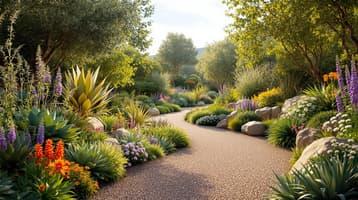
Drought-Resistant Landscaping: A Complete Guide
Transform your garden into a stunning, drought-resistant landscape with smart design, plant choices, and efficient watering methods.
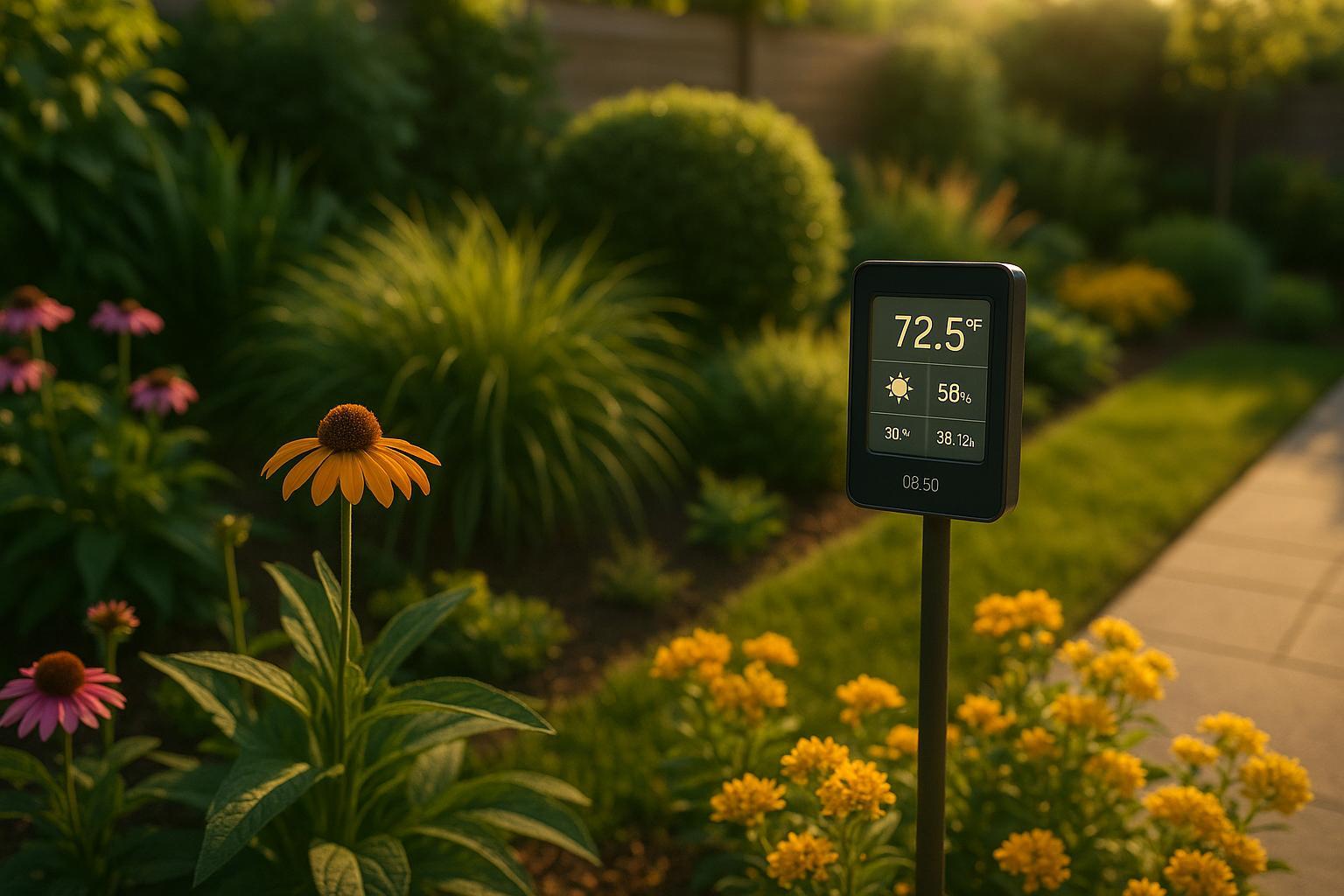
Solving Temperature Fluctuations with AI Tools
Explore how AI tools are revolutionizing garden management by monitoring temperatures, predicting weather, and optimizing plant care for better yields.
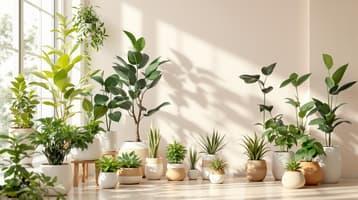
15 Low-Maintenance Plants for Busy Homeowners
Explore 15 low-maintenance plants perfect for busy homeowners seeking greenery without the hassle of intensive care.

Spring Garden Planning Checklist: Essential Steps for Success
Prepare your garden for spring with essential steps, including soil testing, tool maintenance, and planting schedules for a thriving season.
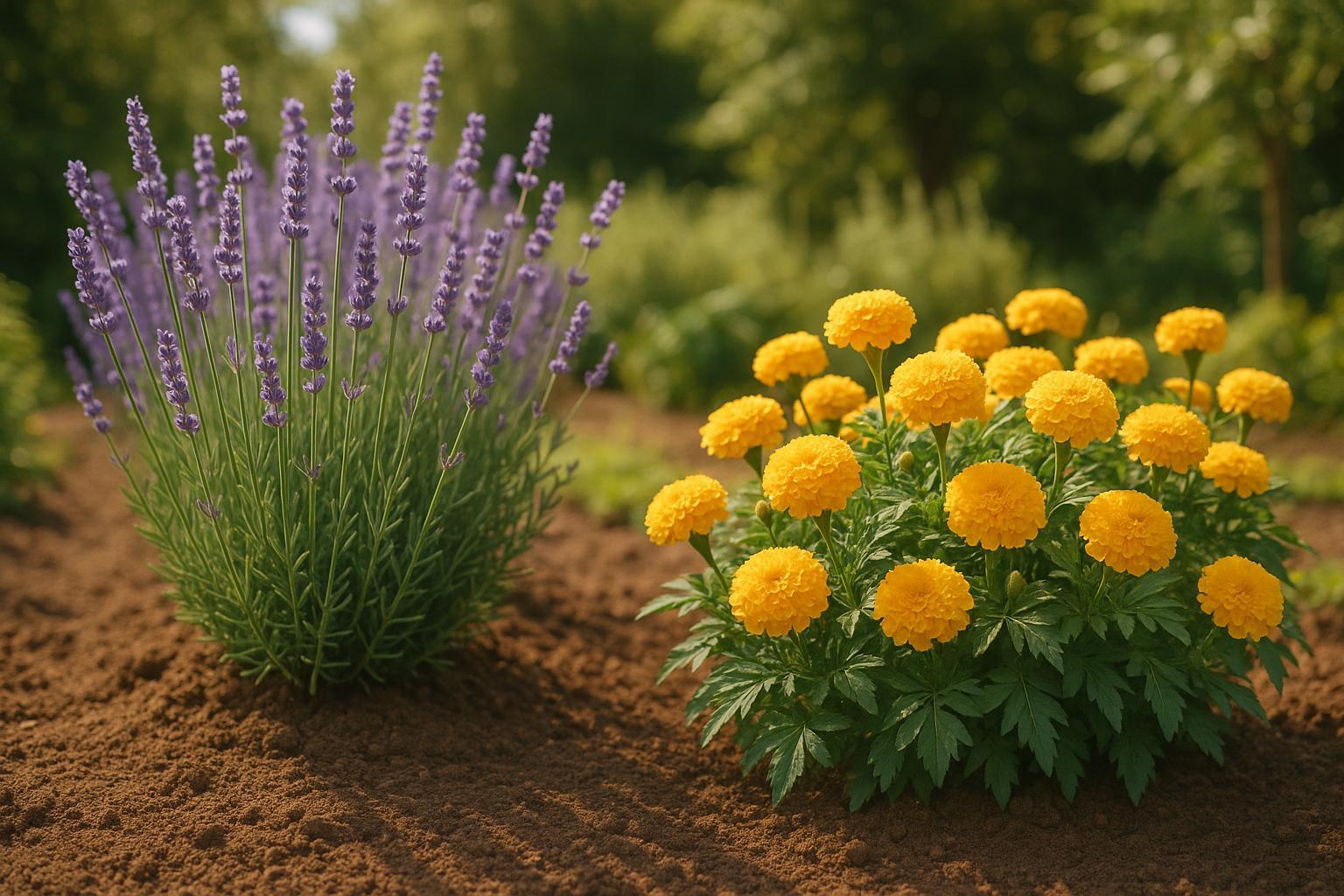
Best Plant Pairings with AI Suggestions
Explore how AI tools revolutionize gardening by providing personalized plant pairings based on climate, soil, and user preferences.
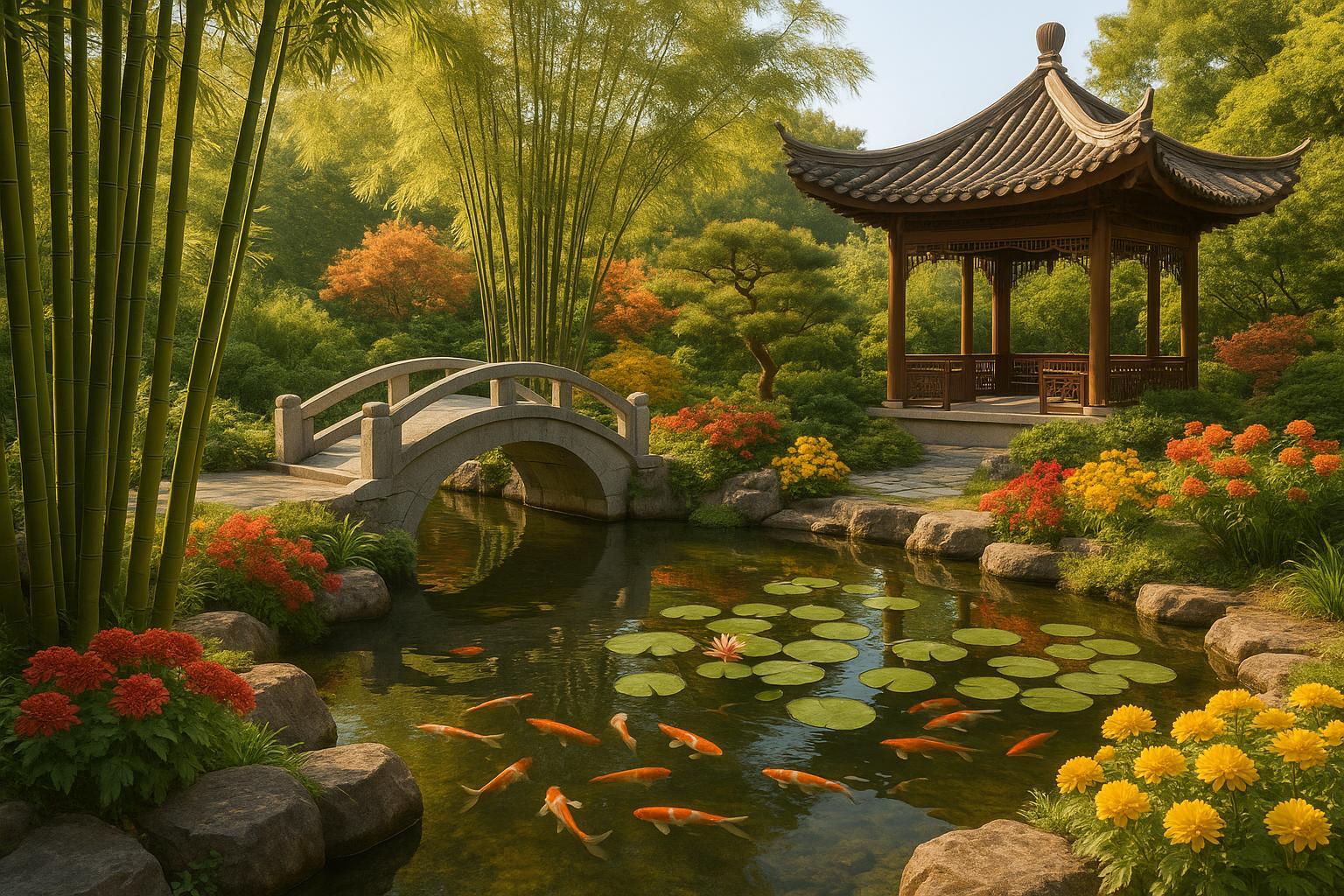
Seasonal Garden Design: Lessons from Chinese Practices
Explore seasonal garden design inspired by Chinese practices, blending nature and philosophy for beauty throughout the year.